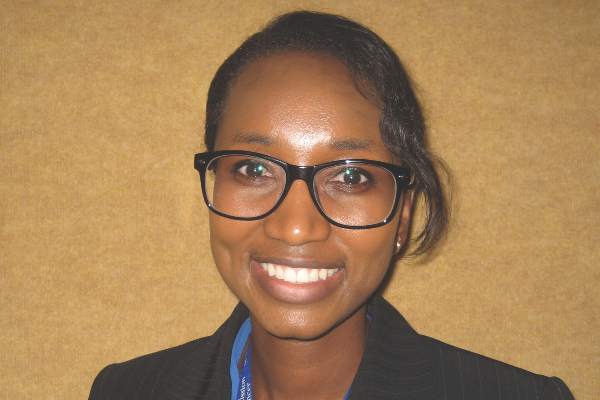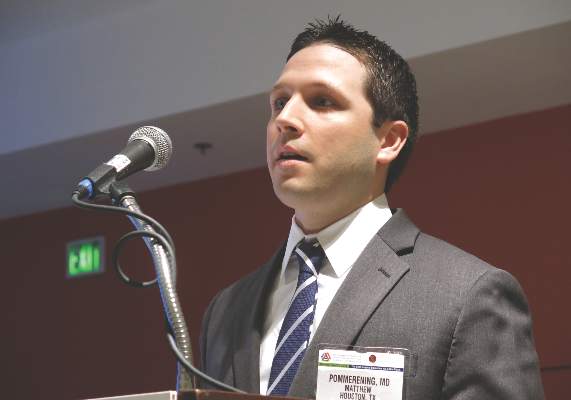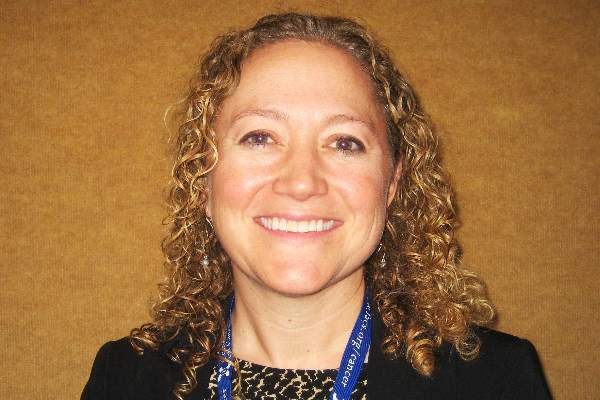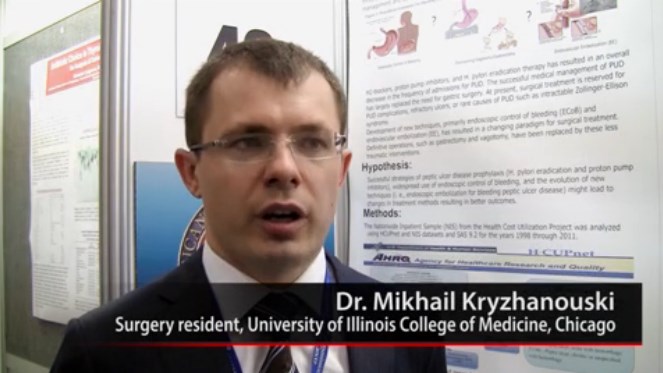User login
American College of Surgeons (ACS): Annual Clinical Congress
Unintended pregnancies fewer with Mirena vs. copper IUD
HONOLULU – The risk of unintended pregnancy was 84% lower with use of levonorgestrel-releasing intrauterine devices than with copper intrauterine devices, according to an analysis of secondary outcomes in a prospective international cohort study of 61,448 women.
EURAS-IUD (the European Active Surveillance Study for Intrauterine Devices) reported its primary outcome in early 2014, showing very low and similar uterine perforation rates in women receiving either levonorgestrel-releasing IUDs or copper IUDs for the first time.
Among secondary outcomes, the levonorgestrel-releasing IUD (Mirena) was associated with a significantly lower risk of unintended pregnancy than were copper IUDs, after adjustment for the influence of age, body mass index, and parity, Dr. Klaas Heinemann Jr. and his associates reported at the annual meeting of the American Society for Reproductive Medicine.
The risk of ectopic pregnancy also was lower with the Mirena than with copper IUDs, showing a 74% decrease in the likelihood of ectopic pregnancy after adjustment for the effects of age, body mass index, and parity, said
Dr. Heinemann of the Berlin Center for Epidemiology and Health Research.
Rates of unintended or ectopic pregnancies were very low in both groups.
Among the 43,078 women receiving the Mirena, follow-up information on 41,001 women aged 18-50 years provided data on 44,633 women-years of observation. Among the 18,370 women receiving copper IUDs, follow-up information on 17,323 women aged 18-50 years provided data on 17,703 women-years of observation.
The 26 contraceptive failures on the Mirena included 13 in women with unrecognized expulsion of the IUD and 1 with a dislocated IUD. The 92 contraceptive failures on copper IUDs included 16 women with unrecognized expulsion of the IUD and 26 with a dislocated IUD.
On the Pearl Index of contraception effectiveness (the number of unintended pregnancies divided by 100 women-years), the Mirena rated 0.06 and copper IUDs rated 0.52, Dr. Heinemann reported. Pregnancy incidence rates were less than 0.08/100 women-years with the Mirena and less than 0.56/100 women-years with copper IUDs.
The lower pregnancy rate with the Mirena was present in all age groups, he added.
Seven confirmed ectopic pregnancies in the Mirena group and 14 in the copper IUD group produced incidence rates of less than 0.05/100 women-years with the Mirena and less than 0.10/100 women-years with copper IUDs.
The 70% of women who received the Mirena tended to be older (mean age, 37 years) than those who got copper IUDs (mean age, 33 years). The women who got the Mirena also were less likely to have delivered a child within the prior year (20%) or to be breast-feeding at the time of insertion (9%), compared with women who got copper IUDs (29% and 15%, respectively).
The research was funded by Bayer, which markets Mirena. Dr. Heinemann is a former employee of Bayer Schering Pharma.
On Twitter @sherryboschert
All contraceptives, particularly IUDs, are very effective. Keep in mind that this is one study that showed a difference between the two IUDs. I don’t think any other studies in the past, in the years that both IUDs have been on the market, have shown this type of phenomenon.
This study was sponsored by a pharmaceutical company. I think you have to take any industry-sponsored results with a grain of salt if they show major differences. My reading of this study is that there are differences, but the differences are much lower than any complications or problems with pregnancy in and of itself, without a contraceptive agent.
The way I would spin this for any prospective patient is that all IUDs, both the levonorgestrel-releasing IUD and the copper IUD, are great methods of contraception. Pregnancy rates are low overall and the risk of ectopic pregnancy is low.
The Pearl Index was below 1, which is good. The Pearl Index for the copper IUD was higher than reported in previous studies. That’s a little unusual.
It’s hard to take a lot from this study other than to say these are two very good methods of contraception. I’m awaiting the full paper before I would be too concerned about changing prescribing habits. If you are a Mirena prescriber, continue to be a Mirena prescriber. I don’t think there’s anything alarming here, although it’s a little surprising because it does go against what’s been shown in previous studies.
Dr. Michael A. Thomas is professor of ob.gyn. and chief of the division of reproductive endocrinology and infertility at the University of Cincinnati. He gave these remarks in an interview. Dr. Thomas has been an adviser to Teva Pharmaceutical Industries, which markets copper IUDs, and has participated in clinical trials that helped bring the Mirena IUD to market.
All contraceptives, particularly IUDs, are very effective. Keep in mind that this is one study that showed a difference between the two IUDs. I don’t think any other studies in the past, in the years that both IUDs have been on the market, have shown this type of phenomenon.
This study was sponsored by a pharmaceutical company. I think you have to take any industry-sponsored results with a grain of salt if they show major differences. My reading of this study is that there are differences, but the differences are much lower than any complications or problems with pregnancy in and of itself, without a contraceptive agent.
The way I would spin this for any prospective patient is that all IUDs, both the levonorgestrel-releasing IUD and the copper IUD, are great methods of contraception. Pregnancy rates are low overall and the risk of ectopic pregnancy is low.
The Pearl Index was below 1, which is good. The Pearl Index for the copper IUD was higher than reported in previous studies. That’s a little unusual.
It’s hard to take a lot from this study other than to say these are two very good methods of contraception. I’m awaiting the full paper before I would be too concerned about changing prescribing habits. If you are a Mirena prescriber, continue to be a Mirena prescriber. I don’t think there’s anything alarming here, although it’s a little surprising because it does go against what’s been shown in previous studies.
Dr. Michael A. Thomas is professor of ob.gyn. and chief of the division of reproductive endocrinology and infertility at the University of Cincinnati. He gave these remarks in an interview. Dr. Thomas has been an adviser to Teva Pharmaceutical Industries, which markets copper IUDs, and has participated in clinical trials that helped bring the Mirena IUD to market.
All contraceptives, particularly IUDs, are very effective. Keep in mind that this is one study that showed a difference between the two IUDs. I don’t think any other studies in the past, in the years that both IUDs have been on the market, have shown this type of phenomenon.
This study was sponsored by a pharmaceutical company. I think you have to take any industry-sponsored results with a grain of salt if they show major differences. My reading of this study is that there are differences, but the differences are much lower than any complications or problems with pregnancy in and of itself, without a contraceptive agent.
The way I would spin this for any prospective patient is that all IUDs, both the levonorgestrel-releasing IUD and the copper IUD, are great methods of contraception. Pregnancy rates are low overall and the risk of ectopic pregnancy is low.
The Pearl Index was below 1, which is good. The Pearl Index for the copper IUD was higher than reported in previous studies. That’s a little unusual.
It’s hard to take a lot from this study other than to say these are two very good methods of contraception. I’m awaiting the full paper before I would be too concerned about changing prescribing habits. If you are a Mirena prescriber, continue to be a Mirena prescriber. I don’t think there’s anything alarming here, although it’s a little surprising because it does go against what’s been shown in previous studies.
Dr. Michael A. Thomas is professor of ob.gyn. and chief of the division of reproductive endocrinology and infertility at the University of Cincinnati. He gave these remarks in an interview. Dr. Thomas has been an adviser to Teva Pharmaceutical Industries, which markets copper IUDs, and has participated in clinical trials that helped bring the Mirena IUD to market.
HONOLULU – The risk of unintended pregnancy was 84% lower with use of levonorgestrel-releasing intrauterine devices than with copper intrauterine devices, according to an analysis of secondary outcomes in a prospective international cohort study of 61,448 women.
EURAS-IUD (the European Active Surveillance Study for Intrauterine Devices) reported its primary outcome in early 2014, showing very low and similar uterine perforation rates in women receiving either levonorgestrel-releasing IUDs or copper IUDs for the first time.
Among secondary outcomes, the levonorgestrel-releasing IUD (Mirena) was associated with a significantly lower risk of unintended pregnancy than were copper IUDs, after adjustment for the influence of age, body mass index, and parity, Dr. Klaas Heinemann Jr. and his associates reported at the annual meeting of the American Society for Reproductive Medicine.
The risk of ectopic pregnancy also was lower with the Mirena than with copper IUDs, showing a 74% decrease in the likelihood of ectopic pregnancy after adjustment for the effects of age, body mass index, and parity, said
Dr. Heinemann of the Berlin Center for Epidemiology and Health Research.
Rates of unintended or ectopic pregnancies were very low in both groups.
Among the 43,078 women receiving the Mirena, follow-up information on 41,001 women aged 18-50 years provided data on 44,633 women-years of observation. Among the 18,370 women receiving copper IUDs, follow-up information on 17,323 women aged 18-50 years provided data on 17,703 women-years of observation.
The 26 contraceptive failures on the Mirena included 13 in women with unrecognized expulsion of the IUD and 1 with a dislocated IUD. The 92 contraceptive failures on copper IUDs included 16 women with unrecognized expulsion of the IUD and 26 with a dislocated IUD.
On the Pearl Index of contraception effectiveness (the number of unintended pregnancies divided by 100 women-years), the Mirena rated 0.06 and copper IUDs rated 0.52, Dr. Heinemann reported. Pregnancy incidence rates were less than 0.08/100 women-years with the Mirena and less than 0.56/100 women-years with copper IUDs.
The lower pregnancy rate with the Mirena was present in all age groups, he added.
Seven confirmed ectopic pregnancies in the Mirena group and 14 in the copper IUD group produced incidence rates of less than 0.05/100 women-years with the Mirena and less than 0.10/100 women-years with copper IUDs.
The 70% of women who received the Mirena tended to be older (mean age, 37 years) than those who got copper IUDs (mean age, 33 years). The women who got the Mirena also were less likely to have delivered a child within the prior year (20%) or to be breast-feeding at the time of insertion (9%), compared with women who got copper IUDs (29% and 15%, respectively).
The research was funded by Bayer, which markets Mirena. Dr. Heinemann is a former employee of Bayer Schering Pharma.
On Twitter @sherryboschert
HONOLULU – The risk of unintended pregnancy was 84% lower with use of levonorgestrel-releasing intrauterine devices than with copper intrauterine devices, according to an analysis of secondary outcomes in a prospective international cohort study of 61,448 women.
EURAS-IUD (the European Active Surveillance Study for Intrauterine Devices) reported its primary outcome in early 2014, showing very low and similar uterine perforation rates in women receiving either levonorgestrel-releasing IUDs or copper IUDs for the first time.
Among secondary outcomes, the levonorgestrel-releasing IUD (Mirena) was associated with a significantly lower risk of unintended pregnancy than were copper IUDs, after adjustment for the influence of age, body mass index, and parity, Dr. Klaas Heinemann Jr. and his associates reported at the annual meeting of the American Society for Reproductive Medicine.
The risk of ectopic pregnancy also was lower with the Mirena than with copper IUDs, showing a 74% decrease in the likelihood of ectopic pregnancy after adjustment for the effects of age, body mass index, and parity, said
Dr. Heinemann of the Berlin Center for Epidemiology and Health Research.
Rates of unintended or ectopic pregnancies were very low in both groups.
Among the 43,078 women receiving the Mirena, follow-up information on 41,001 women aged 18-50 years provided data on 44,633 women-years of observation. Among the 18,370 women receiving copper IUDs, follow-up information on 17,323 women aged 18-50 years provided data on 17,703 women-years of observation.
The 26 contraceptive failures on the Mirena included 13 in women with unrecognized expulsion of the IUD and 1 with a dislocated IUD. The 92 contraceptive failures on copper IUDs included 16 women with unrecognized expulsion of the IUD and 26 with a dislocated IUD.
On the Pearl Index of contraception effectiveness (the number of unintended pregnancies divided by 100 women-years), the Mirena rated 0.06 and copper IUDs rated 0.52, Dr. Heinemann reported. Pregnancy incidence rates were less than 0.08/100 women-years with the Mirena and less than 0.56/100 women-years with copper IUDs.
The lower pregnancy rate with the Mirena was present in all age groups, he added.
Seven confirmed ectopic pregnancies in the Mirena group and 14 in the copper IUD group produced incidence rates of less than 0.05/100 women-years with the Mirena and less than 0.10/100 women-years with copper IUDs.
The 70% of women who received the Mirena tended to be older (mean age, 37 years) than those who got copper IUDs (mean age, 33 years). The women who got the Mirena also were less likely to have delivered a child within the prior year (20%) or to be breast-feeding at the time of insertion (9%), compared with women who got copper IUDs (29% and 15%, respectively).
The research was funded by Bayer, which markets Mirena. Dr. Heinemann is a former employee of Bayer Schering Pharma.
On Twitter @sherryboschert
AT THE ASRM ANNUAL MEETING
Key clinical point: The adjusted risk of unintended pregnancy was 84% lower with levonorgestrel-releasing IUDs than with copper IUDs.
Major finding: Pregnancy incidence rates were less than 0.08/100 women-years with the Mirena and less than 0.56/100 women-years with copper IUDs.
Data source: Secondary outcomes analysis in a prospective, multinational cohort study of 61,448 women receiving IUDs.
Disclosures: The research was funded by Bayer, which markets Mirena. Dr. Heinemann is a former employee of Bayer Schering Pharma.
Antibiotic bowel prep significantly reduces colon surgery infections
SAN FRANCISCO – Oral antibiotics with mechanical bowel preparation significantly reduce surgical site infections, length of hospital stay, and readmissions in both open and laparoscopic elective colorectal surgery, according to a review of 8,415 cases in the National Surgery Quality Improvement Program.
It “should be adopted for elective colorectal surgery,” concluded the investigators, led by colorectal surgeon Melanie Morris of the University of Alabama at Birmingham.
A quarter of the patients had no bowel prep, 45% had mechanical prep alone – GoLytely or another laxative, and 30% received both oral antibiotics and mechanical prep. Partial colectomy and sigmoid resections were the most common procedures, generally for neoplasms or diverticulitis.
Overall, 15% of the no-prep group, 12% of the mechanical prep group, and 6.5% of the oral antibiotic plus mechanical prep group developed subsequent surgical site infections (SSIs), a statistically significant difference. Results were similar when broken down into superficial, deep wound, and organ space infections (J. Am. Coll. Surg. 2014:219;S18-19).
On multivariate analysis and after adjusting for diabetes, smoking, age, and other potential confounders, the antibiotic group was 54% less likely than the no-prep group to develop an SSI (odds ratio 0.46), 26% less likely to be readmitted (OR 0.74), and more likely to leave the hospital earlier, at about 4 days instead of 5 (OR 0.90). SSIs and readmissions were only slightly less likely in the mechanical prep–only group, compared with the no-prep group, and there was no difference in length of stay.
There were fewer anastomotic leaks, fewer cases of sepsis, less significant bleeding, and other benefits for oral antibiotics with mechanical preparation. In addition, there was a protective effect against 30-day mortality in open procedures.
“Even in the minimally invasive group,” about two-thirds of patients, “oral antibiotic prep … was protective for surgical site infections,” Dr. Morris said at the annual clinical congress of the American College of Surgeons.
Still, bowel prep remains “a very controversial topic.” Nationwide some surgeons prep, some don’t. “People have very strong beliefs that may or may not be rooted in the data,” she said.
There are concerns about fluid and electrolyte disturbances, Clostridium difficile overgrowth, and other potential problems. Plus, mechanical preparation hasn’t worked any better than placebo in recent studies, but many of those studies didn’t include oral antibiotics. Effective bowel prep includes both, Dr. Morris said.
It’s possible that confounders might have been at work in the Alabama study. Perhaps surgeons shied away from bowel prep in older, sicker patients, but the rate of acute renal injury was the same in all three study groups at about 0.9%, suggesting similar background comorbidities.
“I don’t think confounding issues” explain the findings. Previously, “we’ve shown the benefit of oral antibiotic bowel prep in a [Veterans Affairs] cohort, and now we’ve shown it in this national cohort,” Dr. Morris said (Dis. Colon. Rectum 2012;55:1160-6).
After a marked reduction in surgical site infections in the VA study, “we changed our practices. We now do mechanical and oral antibiotic preps and have seen a 50% reduction in our SSI rate. We don’t feel like we are doing anything else differently,” she said.
Dr. Morris has no disclosures.
SAN FRANCISCO – Oral antibiotics with mechanical bowel preparation significantly reduce surgical site infections, length of hospital stay, and readmissions in both open and laparoscopic elective colorectal surgery, according to a review of 8,415 cases in the National Surgery Quality Improvement Program.
It “should be adopted for elective colorectal surgery,” concluded the investigators, led by colorectal surgeon Melanie Morris of the University of Alabama at Birmingham.
A quarter of the patients had no bowel prep, 45% had mechanical prep alone – GoLytely or another laxative, and 30% received both oral antibiotics and mechanical prep. Partial colectomy and sigmoid resections were the most common procedures, generally for neoplasms or diverticulitis.
Overall, 15% of the no-prep group, 12% of the mechanical prep group, and 6.5% of the oral antibiotic plus mechanical prep group developed subsequent surgical site infections (SSIs), a statistically significant difference. Results were similar when broken down into superficial, deep wound, and organ space infections (J. Am. Coll. Surg. 2014:219;S18-19).
On multivariate analysis and after adjusting for diabetes, smoking, age, and other potential confounders, the antibiotic group was 54% less likely than the no-prep group to develop an SSI (odds ratio 0.46), 26% less likely to be readmitted (OR 0.74), and more likely to leave the hospital earlier, at about 4 days instead of 5 (OR 0.90). SSIs and readmissions were only slightly less likely in the mechanical prep–only group, compared with the no-prep group, and there was no difference in length of stay.
There were fewer anastomotic leaks, fewer cases of sepsis, less significant bleeding, and other benefits for oral antibiotics with mechanical preparation. In addition, there was a protective effect against 30-day mortality in open procedures.
“Even in the minimally invasive group,” about two-thirds of patients, “oral antibiotic prep … was protective for surgical site infections,” Dr. Morris said at the annual clinical congress of the American College of Surgeons.
Still, bowel prep remains “a very controversial topic.” Nationwide some surgeons prep, some don’t. “People have very strong beliefs that may or may not be rooted in the data,” she said.
There are concerns about fluid and electrolyte disturbances, Clostridium difficile overgrowth, and other potential problems. Plus, mechanical preparation hasn’t worked any better than placebo in recent studies, but many of those studies didn’t include oral antibiotics. Effective bowel prep includes both, Dr. Morris said.
It’s possible that confounders might have been at work in the Alabama study. Perhaps surgeons shied away from bowel prep in older, sicker patients, but the rate of acute renal injury was the same in all three study groups at about 0.9%, suggesting similar background comorbidities.
“I don’t think confounding issues” explain the findings. Previously, “we’ve shown the benefit of oral antibiotic bowel prep in a [Veterans Affairs] cohort, and now we’ve shown it in this national cohort,” Dr. Morris said (Dis. Colon. Rectum 2012;55:1160-6).
After a marked reduction in surgical site infections in the VA study, “we changed our practices. We now do mechanical and oral antibiotic preps and have seen a 50% reduction in our SSI rate. We don’t feel like we are doing anything else differently,” she said.
Dr. Morris has no disclosures.
SAN FRANCISCO – Oral antibiotics with mechanical bowel preparation significantly reduce surgical site infections, length of hospital stay, and readmissions in both open and laparoscopic elective colorectal surgery, according to a review of 8,415 cases in the National Surgery Quality Improvement Program.
It “should be adopted for elective colorectal surgery,” concluded the investigators, led by colorectal surgeon Melanie Morris of the University of Alabama at Birmingham.
A quarter of the patients had no bowel prep, 45% had mechanical prep alone – GoLytely or another laxative, and 30% received both oral antibiotics and mechanical prep. Partial colectomy and sigmoid resections were the most common procedures, generally for neoplasms or diverticulitis.
Overall, 15% of the no-prep group, 12% of the mechanical prep group, and 6.5% of the oral antibiotic plus mechanical prep group developed subsequent surgical site infections (SSIs), a statistically significant difference. Results were similar when broken down into superficial, deep wound, and organ space infections (J. Am. Coll. Surg. 2014:219;S18-19).
On multivariate analysis and after adjusting for diabetes, smoking, age, and other potential confounders, the antibiotic group was 54% less likely than the no-prep group to develop an SSI (odds ratio 0.46), 26% less likely to be readmitted (OR 0.74), and more likely to leave the hospital earlier, at about 4 days instead of 5 (OR 0.90). SSIs and readmissions were only slightly less likely in the mechanical prep–only group, compared with the no-prep group, and there was no difference in length of stay.
There were fewer anastomotic leaks, fewer cases of sepsis, less significant bleeding, and other benefits for oral antibiotics with mechanical preparation. In addition, there was a protective effect against 30-day mortality in open procedures.
“Even in the minimally invasive group,” about two-thirds of patients, “oral antibiotic prep … was protective for surgical site infections,” Dr. Morris said at the annual clinical congress of the American College of Surgeons.
Still, bowel prep remains “a very controversial topic.” Nationwide some surgeons prep, some don’t. “People have very strong beliefs that may or may not be rooted in the data,” she said.
There are concerns about fluid and electrolyte disturbances, Clostridium difficile overgrowth, and other potential problems. Plus, mechanical preparation hasn’t worked any better than placebo in recent studies, but many of those studies didn’t include oral antibiotics. Effective bowel prep includes both, Dr. Morris said.
It’s possible that confounders might have been at work in the Alabama study. Perhaps surgeons shied away from bowel prep in older, sicker patients, but the rate of acute renal injury was the same in all three study groups at about 0.9%, suggesting similar background comorbidities.
“I don’t think confounding issues” explain the findings. Previously, “we’ve shown the benefit of oral antibiotic bowel prep in a [Veterans Affairs] cohort, and now we’ve shown it in this national cohort,” Dr. Morris said (Dis. Colon. Rectum 2012;55:1160-6).
After a marked reduction in surgical site infections in the VA study, “we changed our practices. We now do mechanical and oral antibiotic preps and have seen a 50% reduction in our SSI rate. We don’t feel like we are doing anything else differently,” she said.
Dr. Morris has no disclosures.
AT THE ACS CLINICAL CONGRESS
Key clinical point: Effective bowel prep must include oral antibiotics as well as laxatives.
Major finding: Prepping colorectal surgery patients with both oral antibiotics and laxatives halves the risk of surgery site infections (OR 0.46, 95% CI 0.36-0.59, P < .001),
Data source: Review of 8,415 cases in the National Surgery Quality Improvement Program
Disclosures: Dr. Morris has no relevant financial disclosures.
Low-stage colon cancers need to be followed post surgery for recurrence
SAN FRANCISCO – Patients with stage I colorectal cancer should be followed as closely as patients with higher-stage primary tumors after resection, according to a prospective 6-year surveillance study of 1,202 British patients.
The reason is that the incidence of recurrences that can be treated surgically with curative intent is the same in stage I patients as it is in patients with stage II and III primaries, about 6% (J. Am. Coll. Surg. 2014:219;e46-47).
Following resection with clear margins, the patients were randomized about 300 per group to either serial CT surveillance, serial carcinoembryonic antigen (CEA) monitoring, both, or minimum surveillance, and followed for a median of 4.4 years. About a quarter of the subjects had Dukes’ A primaries and a quarter Dukes’ C primaries, and about half had Dukes’ B primaries. The A, B, C designations are similar to the stage I, II, and III designations more common in the United States.
On both sides of the Atlantic, guidelines focus on active surveillance for higher-stage primaries, but are ambivalent about monitoring stage I tumors because they are less likely to recur and the benefit of follow-up has been uncertain.
That needs to change because treatable recurrences are what matters, and they are as likely in low-stage disease as in high-stage disease, lead investigator Dr. Sian Pugh, a colorectal surgeon at the University of Southampton (England), said at the annual clinical congress of the American College of Surgeons.
“Picking up recurrences that are not treatable doesn’t help anyone; it just gives you bad news earlier,” she said. The benefit of follow-up is “finding treatable disease, and that’s independent of the stage of the primary tumor. We recommend equivalent follow-up for all patients with resected Dukes’ A-C colorectal cancer. The guidelines [should] be reconsidered,” she asserted.
Her team also thinks that the most cost-effective way to monitor patients is probably with CEA monitoring every 3 months for the first 2 years, CEA monitoring every 6 months thereafter until year 5, and a single CT at 12-18 months to catch recurrences that don’t express CEA. That strategy was three times more likely than minimal surveillance to find treatable recurrences, about the same as serial CTs and serial CTs with regular CEA monitoring.
“We don’t think patients need to be followed up quite as intensively as the guidelines suggest,” – for instance, CT scans every 6 months – “but we are waiting for more health economic analysis,” Dr. Pugh said.
Although treatable recurrences were equally likely in all the groups, they were more common in patients with lower-stage primary cancers. Among recurrences in patients with Dukes’ A primary tumors, 50% (13/26) were treated surgically with curative intent, compared with 40% (32/81) in patients with Dukes’ B primaries and 24% (20/82) in those with Dukes’ C.
Pulmonary recurrence was most frequent with rectal primary tumors, and multisite recurrence was most common from right-colonic cancers. Median survival following recurrence was 2.28 years and was influenced by stage and site of primary. Following recurrence, survival was highest in those with lower-stage and rectal primaries, and lowest in patients with higher-stage primaries and recurrence from the right colon.
Dr. Pugh had no disclosures. The work was funded by the U.K. National Health Service.
There’s a lot of heterogeneity in the United States with regard to how frequently people get surveillance imaging and CEA for colon cancer recurrence. The study is helpful because it presents data that inform the decision.
These data suggest that CEA on a regular basis and a CT scan at 1 year are enough. This may be a more rational, cost-effective way to screen people and still achieve what we’re trying to achieve: picking up treatable recurrences.
Dr. Timothy Pawlik is chief of the division of surgical oncology and a professor of surgery at Johns Hopkins University, Baltimore.
There’s a lot of heterogeneity in the United States with regard to how frequently people get surveillance imaging and CEA for colon cancer recurrence. The study is helpful because it presents data that inform the decision.
These data suggest that CEA on a regular basis and a CT scan at 1 year are enough. This may be a more rational, cost-effective way to screen people and still achieve what we’re trying to achieve: picking up treatable recurrences.
Dr. Timothy Pawlik is chief of the division of surgical oncology and a professor of surgery at Johns Hopkins University, Baltimore.
There’s a lot of heterogeneity in the United States with regard to how frequently people get surveillance imaging and CEA for colon cancer recurrence. The study is helpful because it presents data that inform the decision.
These data suggest that CEA on a regular basis and a CT scan at 1 year are enough. This may be a more rational, cost-effective way to screen people and still achieve what we’re trying to achieve: picking up treatable recurrences.
Dr. Timothy Pawlik is chief of the division of surgical oncology and a professor of surgery at Johns Hopkins University, Baltimore.
SAN FRANCISCO – Patients with stage I colorectal cancer should be followed as closely as patients with higher-stage primary tumors after resection, according to a prospective 6-year surveillance study of 1,202 British patients.
The reason is that the incidence of recurrences that can be treated surgically with curative intent is the same in stage I patients as it is in patients with stage II and III primaries, about 6% (J. Am. Coll. Surg. 2014:219;e46-47).
Following resection with clear margins, the patients were randomized about 300 per group to either serial CT surveillance, serial carcinoembryonic antigen (CEA) monitoring, both, or minimum surveillance, and followed for a median of 4.4 years. About a quarter of the subjects had Dukes’ A primaries and a quarter Dukes’ C primaries, and about half had Dukes’ B primaries. The A, B, C designations are similar to the stage I, II, and III designations more common in the United States.
On both sides of the Atlantic, guidelines focus on active surveillance for higher-stage primaries, but are ambivalent about monitoring stage I tumors because they are less likely to recur and the benefit of follow-up has been uncertain.
That needs to change because treatable recurrences are what matters, and they are as likely in low-stage disease as in high-stage disease, lead investigator Dr. Sian Pugh, a colorectal surgeon at the University of Southampton (England), said at the annual clinical congress of the American College of Surgeons.
“Picking up recurrences that are not treatable doesn’t help anyone; it just gives you bad news earlier,” she said. The benefit of follow-up is “finding treatable disease, and that’s independent of the stage of the primary tumor. We recommend equivalent follow-up for all patients with resected Dukes’ A-C colorectal cancer. The guidelines [should] be reconsidered,” she asserted.
Her team also thinks that the most cost-effective way to monitor patients is probably with CEA monitoring every 3 months for the first 2 years, CEA monitoring every 6 months thereafter until year 5, and a single CT at 12-18 months to catch recurrences that don’t express CEA. That strategy was three times more likely than minimal surveillance to find treatable recurrences, about the same as serial CTs and serial CTs with regular CEA monitoring.
“We don’t think patients need to be followed up quite as intensively as the guidelines suggest,” – for instance, CT scans every 6 months – “but we are waiting for more health economic analysis,” Dr. Pugh said.
Although treatable recurrences were equally likely in all the groups, they were more common in patients with lower-stage primary cancers. Among recurrences in patients with Dukes’ A primary tumors, 50% (13/26) were treated surgically with curative intent, compared with 40% (32/81) in patients with Dukes’ B primaries and 24% (20/82) in those with Dukes’ C.
Pulmonary recurrence was most frequent with rectal primary tumors, and multisite recurrence was most common from right-colonic cancers. Median survival following recurrence was 2.28 years and was influenced by stage and site of primary. Following recurrence, survival was highest in those with lower-stage and rectal primaries, and lowest in patients with higher-stage primaries and recurrence from the right colon.
Dr. Pugh had no disclosures. The work was funded by the U.K. National Health Service.
SAN FRANCISCO – Patients with stage I colorectal cancer should be followed as closely as patients with higher-stage primary tumors after resection, according to a prospective 6-year surveillance study of 1,202 British patients.
The reason is that the incidence of recurrences that can be treated surgically with curative intent is the same in stage I patients as it is in patients with stage II and III primaries, about 6% (J. Am. Coll. Surg. 2014:219;e46-47).
Following resection with clear margins, the patients were randomized about 300 per group to either serial CT surveillance, serial carcinoembryonic antigen (CEA) monitoring, both, or minimum surveillance, and followed for a median of 4.4 years. About a quarter of the subjects had Dukes’ A primaries and a quarter Dukes’ C primaries, and about half had Dukes’ B primaries. The A, B, C designations are similar to the stage I, II, and III designations more common in the United States.
On both sides of the Atlantic, guidelines focus on active surveillance for higher-stage primaries, but are ambivalent about monitoring stage I tumors because they are less likely to recur and the benefit of follow-up has been uncertain.
That needs to change because treatable recurrences are what matters, and they are as likely in low-stage disease as in high-stage disease, lead investigator Dr. Sian Pugh, a colorectal surgeon at the University of Southampton (England), said at the annual clinical congress of the American College of Surgeons.
“Picking up recurrences that are not treatable doesn’t help anyone; it just gives you bad news earlier,” she said. The benefit of follow-up is “finding treatable disease, and that’s independent of the stage of the primary tumor. We recommend equivalent follow-up for all patients with resected Dukes’ A-C colorectal cancer. The guidelines [should] be reconsidered,” she asserted.
Her team also thinks that the most cost-effective way to monitor patients is probably with CEA monitoring every 3 months for the first 2 years, CEA monitoring every 6 months thereafter until year 5, and a single CT at 12-18 months to catch recurrences that don’t express CEA. That strategy was three times more likely than minimal surveillance to find treatable recurrences, about the same as serial CTs and serial CTs with regular CEA monitoring.
“We don’t think patients need to be followed up quite as intensively as the guidelines suggest,” – for instance, CT scans every 6 months – “but we are waiting for more health economic analysis,” Dr. Pugh said.
Although treatable recurrences were equally likely in all the groups, they were more common in patients with lower-stage primary cancers. Among recurrences in patients with Dukes’ A primary tumors, 50% (13/26) were treated surgically with curative intent, compared with 40% (32/81) in patients with Dukes’ B primaries and 24% (20/82) in those with Dukes’ C.
Pulmonary recurrence was most frequent with rectal primary tumors, and multisite recurrence was most common from right-colonic cancers. Median survival following recurrence was 2.28 years and was influenced by stage and site of primary. Following recurrence, survival was highest in those with lower-stage and rectal primaries, and lowest in patients with higher-stage primaries and recurrence from the right colon.
Dr. Pugh had no disclosures. The work was funded by the U.K. National Health Service.
Key clinical point: The incidence of treatable recurrence is the same regardless of the stage of the primary colon tumor.
Major finding: Six percent of recurrent stage I, II, and III colon cancers can be treated surgically with curative intent.
Data source: Randomized surveillance study of 1,202 British colon cancer patients after removal of their primary tumors.
Disclosures: Dr. Pugh had no disclosures. The work was funded by the U.K. National Health Service.
Vascular surgeons have better outcomes for aneurysm repair, endarterectomy
SAN FRANCISCO – Patients undergoing carotid endarterectomy and open abdominal aortic aneurysm repair are less likely to have complications and die if their surgeon is a vascular specialist, according to a study reported at the annual clinical congress of the American College of Surgeons.
“We feel that carotid endarterectomy and open triple-A repair performed by a vascular surgeon is an independent predictor of improved morbidity and mortality. Hospitals should consider utilizing this specialty-specific information to identify potential quality improvement initiatives,” recommended lead investigator Dr. Carla C. Moreira, a surgeon in the division of vascular and endovascular surgery, Boston Medical Center.
She and her colleagues analyzed data from the American College of Surgeons National Surgical Quality Improvement Program (NSQIP), assessing outcomes for 94,029 patients who underwent open vascular procedures between 2006 and 2012. Some 8% had abdominal aneurysm repairs, 57% had carotid endarterectomies, and 35% had lower-extremity bypasses.
Overall, 94% of the procedures were performed by vascular surgeons, while the rest were performed by other types of surgeons (including cardiac surgeons because their numbers were too small to tease out, according to Dr. Moreira).
Results showed that for patients undergoing abdominal aneurysm repair, the unadjusted rate of 30-day mortality did not differ significantly by surgeon specialty. However, in multivariate, propensity-matched analysis, the odds of complications were reduced by half when the repair was done by a vascular surgeon as compared with some other type of surgeon (odds ratio, 0.50).
Patients undergoing carotid endarterectomy had a lower unadjusted mortality if the operation was performed by a vascular surgeon (0.7% vs. 1.0%), although the difference was no longer significant after multivariate adjustment. However, they had significantly lower adjusted odds of complications (odds ratio, 0.62).
For patients undergoing lower-extremity bypass, neither the rate of mortality nor the odds of complications differed significantly by surgeon specialty.
An analysis of temporal trends showed that the proportions of all eligible patients undergoing open abdominal aneurysm repair and lower-extremity bypass during the study period fell, regardless of surgeon type, whereas the proportion of eligible patients undergoing carotid endarterectomies remained stable. “I think this is reflective likely of the penetration of endovascular procedures when it comes to the treatment of abdominal aneurysm and lower-extremity peripheral arterial disease, as compared to carotid disease,” speculated Dr. Moreira, who disclosed that she had no relevant conflicts of interest.
Session moderator Dr. Peter K. Henke, associate chair of research, department of surgery, and Leland Ira Doan Professor of Vascular Surgery at the University of Michigan in Ann Arbor, asked whether the findings have implications for surgeon training.
“Our results were different from what has been previously published for open aneurysm repair. I think that open aneurysm repair is probably becoming more and more specialized in terms that more and more, you are going to see just vascular surgeons performing it as compared to other specialties, especially as I have shown that there is a decreasing number of general surgeons being exposed to open vascular procedures,” Dr. Moreira replied. “So I think this [speaks] to individual surgeons and their individual experience with triple-A repair. Our data does show that general surgeons who are performing these procedures are doing a good job because there is not a difference in outcome at least in terms of mortality. But as the easy triple-A repairs go away, I think it’s going to push the procedure to be done more by specialized surgeons.”
In an interview, Dr. Henke commented, “I think it has been alluded to in other studies and other reports in the literature, but this study brings to the forefront the fact that overall numbers of open vascular procedures are less and less, so the surgeons performing those procedures need to be specialists. And I’d say within the U.S. anyway, most practitioners who do vascular procedures are vascular surgeons or cardiovascularly trained, as compared with general surgeons. I suspect that some of the general surgeons who are still doing these procedures may be at a place where they are the only ones who can do it or there are no vascular specialists there.
“The other issue that this study may impact, as more of these reports come out, is hospital credentialing, because hospital credentialing of surgeons really determines what they can and cannot do at that hospital,” he added. “So as more hospital credentialing boards see this type of data, I think they will limit open vascular procedures to vascular specialists who have had training in vascular disease.”
SAN FRANCISCO – Patients undergoing carotid endarterectomy and open abdominal aortic aneurysm repair are less likely to have complications and die if their surgeon is a vascular specialist, according to a study reported at the annual clinical congress of the American College of Surgeons.
“We feel that carotid endarterectomy and open triple-A repair performed by a vascular surgeon is an independent predictor of improved morbidity and mortality. Hospitals should consider utilizing this specialty-specific information to identify potential quality improvement initiatives,” recommended lead investigator Dr. Carla C. Moreira, a surgeon in the division of vascular and endovascular surgery, Boston Medical Center.
She and her colleagues analyzed data from the American College of Surgeons National Surgical Quality Improvement Program (NSQIP), assessing outcomes for 94,029 patients who underwent open vascular procedures between 2006 and 2012. Some 8% had abdominal aneurysm repairs, 57% had carotid endarterectomies, and 35% had lower-extremity bypasses.
Overall, 94% of the procedures were performed by vascular surgeons, while the rest were performed by other types of surgeons (including cardiac surgeons because their numbers were too small to tease out, according to Dr. Moreira).
Results showed that for patients undergoing abdominal aneurysm repair, the unadjusted rate of 30-day mortality did not differ significantly by surgeon specialty. However, in multivariate, propensity-matched analysis, the odds of complications were reduced by half when the repair was done by a vascular surgeon as compared with some other type of surgeon (odds ratio, 0.50).
Patients undergoing carotid endarterectomy had a lower unadjusted mortality if the operation was performed by a vascular surgeon (0.7% vs. 1.0%), although the difference was no longer significant after multivariate adjustment. However, they had significantly lower adjusted odds of complications (odds ratio, 0.62).
For patients undergoing lower-extremity bypass, neither the rate of mortality nor the odds of complications differed significantly by surgeon specialty.
An analysis of temporal trends showed that the proportions of all eligible patients undergoing open abdominal aneurysm repair and lower-extremity bypass during the study period fell, regardless of surgeon type, whereas the proportion of eligible patients undergoing carotid endarterectomies remained stable. “I think this is reflective likely of the penetration of endovascular procedures when it comes to the treatment of abdominal aneurysm and lower-extremity peripheral arterial disease, as compared to carotid disease,” speculated Dr. Moreira, who disclosed that she had no relevant conflicts of interest.
Session moderator Dr. Peter K. Henke, associate chair of research, department of surgery, and Leland Ira Doan Professor of Vascular Surgery at the University of Michigan in Ann Arbor, asked whether the findings have implications for surgeon training.
“Our results were different from what has been previously published for open aneurysm repair. I think that open aneurysm repair is probably becoming more and more specialized in terms that more and more, you are going to see just vascular surgeons performing it as compared to other specialties, especially as I have shown that there is a decreasing number of general surgeons being exposed to open vascular procedures,” Dr. Moreira replied. “So I think this [speaks] to individual surgeons and their individual experience with triple-A repair. Our data does show that general surgeons who are performing these procedures are doing a good job because there is not a difference in outcome at least in terms of mortality. But as the easy triple-A repairs go away, I think it’s going to push the procedure to be done more by specialized surgeons.”
In an interview, Dr. Henke commented, “I think it has been alluded to in other studies and other reports in the literature, but this study brings to the forefront the fact that overall numbers of open vascular procedures are less and less, so the surgeons performing those procedures need to be specialists. And I’d say within the U.S. anyway, most practitioners who do vascular procedures are vascular surgeons or cardiovascularly trained, as compared with general surgeons. I suspect that some of the general surgeons who are still doing these procedures may be at a place where they are the only ones who can do it or there are no vascular specialists there.
“The other issue that this study may impact, as more of these reports come out, is hospital credentialing, because hospital credentialing of surgeons really determines what they can and cannot do at that hospital,” he added. “So as more hospital credentialing boards see this type of data, I think they will limit open vascular procedures to vascular specialists who have had training in vascular disease.”
SAN FRANCISCO – Patients undergoing carotid endarterectomy and open abdominal aortic aneurysm repair are less likely to have complications and die if their surgeon is a vascular specialist, according to a study reported at the annual clinical congress of the American College of Surgeons.
“We feel that carotid endarterectomy and open triple-A repair performed by a vascular surgeon is an independent predictor of improved morbidity and mortality. Hospitals should consider utilizing this specialty-specific information to identify potential quality improvement initiatives,” recommended lead investigator Dr. Carla C. Moreira, a surgeon in the division of vascular and endovascular surgery, Boston Medical Center.
She and her colleagues analyzed data from the American College of Surgeons National Surgical Quality Improvement Program (NSQIP), assessing outcomes for 94,029 patients who underwent open vascular procedures between 2006 and 2012. Some 8% had abdominal aneurysm repairs, 57% had carotid endarterectomies, and 35% had lower-extremity bypasses.
Overall, 94% of the procedures were performed by vascular surgeons, while the rest were performed by other types of surgeons (including cardiac surgeons because their numbers were too small to tease out, according to Dr. Moreira).
Results showed that for patients undergoing abdominal aneurysm repair, the unadjusted rate of 30-day mortality did not differ significantly by surgeon specialty. However, in multivariate, propensity-matched analysis, the odds of complications were reduced by half when the repair was done by a vascular surgeon as compared with some other type of surgeon (odds ratio, 0.50).
Patients undergoing carotid endarterectomy had a lower unadjusted mortality if the operation was performed by a vascular surgeon (0.7% vs. 1.0%), although the difference was no longer significant after multivariate adjustment. However, they had significantly lower adjusted odds of complications (odds ratio, 0.62).
For patients undergoing lower-extremity bypass, neither the rate of mortality nor the odds of complications differed significantly by surgeon specialty.
An analysis of temporal trends showed that the proportions of all eligible patients undergoing open abdominal aneurysm repair and lower-extremity bypass during the study period fell, regardless of surgeon type, whereas the proportion of eligible patients undergoing carotid endarterectomies remained stable. “I think this is reflective likely of the penetration of endovascular procedures when it comes to the treatment of abdominal aneurysm and lower-extremity peripheral arterial disease, as compared to carotid disease,” speculated Dr. Moreira, who disclosed that she had no relevant conflicts of interest.
Session moderator Dr. Peter K. Henke, associate chair of research, department of surgery, and Leland Ira Doan Professor of Vascular Surgery at the University of Michigan in Ann Arbor, asked whether the findings have implications for surgeon training.
“Our results were different from what has been previously published for open aneurysm repair. I think that open aneurysm repair is probably becoming more and more specialized in terms that more and more, you are going to see just vascular surgeons performing it as compared to other specialties, especially as I have shown that there is a decreasing number of general surgeons being exposed to open vascular procedures,” Dr. Moreira replied. “So I think this [speaks] to individual surgeons and their individual experience with triple-A repair. Our data does show that general surgeons who are performing these procedures are doing a good job because there is not a difference in outcome at least in terms of mortality. But as the easy triple-A repairs go away, I think it’s going to push the procedure to be done more by specialized surgeons.”
In an interview, Dr. Henke commented, “I think it has been alluded to in other studies and other reports in the literature, but this study brings to the forefront the fact that overall numbers of open vascular procedures are less and less, so the surgeons performing those procedures need to be specialists. And I’d say within the U.S. anyway, most practitioners who do vascular procedures are vascular surgeons or cardiovascularly trained, as compared with general surgeons. I suspect that some of the general surgeons who are still doing these procedures may be at a place where they are the only ones who can do it or there are no vascular specialists there.
“The other issue that this study may impact, as more of these reports come out, is hospital credentialing, because hospital credentialing of surgeons really determines what they can and cannot do at that hospital,” he added. “So as more hospital credentialing boards see this type of data, I think they will limit open vascular procedures to vascular specialists who have had training in vascular disease.”
AT THE ACS CLINICAL CONGRESS
Key clinical point: Patients undergoing certain open vascular procedures have better outcomes when operated on by vascular surgeons.
Major finding: Vascular surgeons achieved lower rates of morbidity and mortality in cases of open abdominal aneurysm repair and carotid endarterectomy.
Data source: An analysis of NSQIP data for 94,029 patients undergoing open vascular procedures.
Disclosures: Dr. Moreira disclosed that she had no relevant conflicts of interest.
Better thromboprophylaxis didn’t reduce emboli after trauma
SAN FRANCISCO – Delivering prophylactic therapies against venous thromboembolism sooner and to more patients admitted for trauma failed to reduce the risk of pulmonary embolism in a 6-year study of data on 23,863 patients.
Dr. Matthew J. Pommerening and his associates at the University of Texas, Houston, retrospectively studied data on the management and outcomes of 11,292 adults admitted to their level 1 trauma center in 2006-2008 before implementation of a performance-improvement program, and 12,571 patients admitted in 2009-2011, after the program was in place.
The performance-improvement program included sequential interventions such as audits for missed doses of thromboprophylactic medications, goals for earlier and more aggressive chemical prophylaxis, and placing prophylactic filters in the inferior vena cava (IVC) in high-risk patients.
Overall, 1% of patients developed a pulmonary embolism. Comparing rates of pulmonary emboli, deaths from pulmonary embolism, or mortality in the preprogram and postprogram time periods, however, showed no significant differences, he said at the annual clinical congress of the American College of Surgeons.
One percent of patients in both time periods developed a pulmonary embolism. The rate of death from pulmonary embolism was 7% in the earlier period and 8% in the later period. Mortality rates were 4.5% in both periods.
That’s despite great improvements in reducing the proportion of patients who got no prophylaxis from 45% in the earlier period to 11% under the improvement program. The use of prophylactic IVC filters increased from 3% in the earlier period to nearly 8% under the program. The time to initiation of prophylaxis decreased from 57 hours to 32 hours, on average.
The proportion of patients who missed a dose of thromboprophylaxis did not change significantly, from 39% in the earlier period to 36% under the program.
“Current prophylactic strategies and therapies for pulmonary embolism may be inadequate,” Dr. Pommerening said, perhaps due to inadequate dosing or inadequate therapies. The utility or potential thrombogenicity of IVC filters is a topic of “serious discussion” at his institution, he said.
“There’s still room for improvement,” he added, by eliminating missed doses and reducing the 11% of patients who got no prophylaxis, he added.
The time to diagnosis of pulmonary embolism and the proportion of emboli located in the main pulmonary artery did not differ significantly by time period.
The size of the study may not have provided enough power to detect differences in rates of emboli between time periods with such a low overall rate of pulmonary emboli to begin with, he said.
The investigators have started to look at whether the performance improvement program made any difference in the rate of deep-vein thrombosis.
Dr. Pommerening reported having no financial disclosures.
On Twitter @sherryboschert
SAN FRANCISCO – Delivering prophylactic therapies against venous thromboembolism sooner and to more patients admitted for trauma failed to reduce the risk of pulmonary embolism in a 6-year study of data on 23,863 patients.
Dr. Matthew J. Pommerening and his associates at the University of Texas, Houston, retrospectively studied data on the management and outcomes of 11,292 adults admitted to their level 1 trauma center in 2006-2008 before implementation of a performance-improvement program, and 12,571 patients admitted in 2009-2011, after the program was in place.
The performance-improvement program included sequential interventions such as audits for missed doses of thromboprophylactic medications, goals for earlier and more aggressive chemical prophylaxis, and placing prophylactic filters in the inferior vena cava (IVC) in high-risk patients.
Overall, 1% of patients developed a pulmonary embolism. Comparing rates of pulmonary emboli, deaths from pulmonary embolism, or mortality in the preprogram and postprogram time periods, however, showed no significant differences, he said at the annual clinical congress of the American College of Surgeons.
One percent of patients in both time periods developed a pulmonary embolism. The rate of death from pulmonary embolism was 7% in the earlier period and 8% in the later period. Mortality rates were 4.5% in both periods.
That’s despite great improvements in reducing the proportion of patients who got no prophylaxis from 45% in the earlier period to 11% under the improvement program. The use of prophylactic IVC filters increased from 3% in the earlier period to nearly 8% under the program. The time to initiation of prophylaxis decreased from 57 hours to 32 hours, on average.
The proportion of patients who missed a dose of thromboprophylaxis did not change significantly, from 39% in the earlier period to 36% under the program.
“Current prophylactic strategies and therapies for pulmonary embolism may be inadequate,” Dr. Pommerening said, perhaps due to inadequate dosing or inadequate therapies. The utility or potential thrombogenicity of IVC filters is a topic of “serious discussion” at his institution, he said.
“There’s still room for improvement,” he added, by eliminating missed doses and reducing the 11% of patients who got no prophylaxis, he added.
The time to diagnosis of pulmonary embolism and the proportion of emboli located in the main pulmonary artery did not differ significantly by time period.
The size of the study may not have provided enough power to detect differences in rates of emboli between time periods with such a low overall rate of pulmonary emboli to begin with, he said.
The investigators have started to look at whether the performance improvement program made any difference in the rate of deep-vein thrombosis.
Dr. Pommerening reported having no financial disclosures.
On Twitter @sherryboschert
SAN FRANCISCO – Delivering prophylactic therapies against venous thromboembolism sooner and to more patients admitted for trauma failed to reduce the risk of pulmonary embolism in a 6-year study of data on 23,863 patients.
Dr. Matthew J. Pommerening and his associates at the University of Texas, Houston, retrospectively studied data on the management and outcomes of 11,292 adults admitted to their level 1 trauma center in 2006-2008 before implementation of a performance-improvement program, and 12,571 patients admitted in 2009-2011, after the program was in place.
The performance-improvement program included sequential interventions such as audits for missed doses of thromboprophylactic medications, goals for earlier and more aggressive chemical prophylaxis, and placing prophylactic filters in the inferior vena cava (IVC) in high-risk patients.
Overall, 1% of patients developed a pulmonary embolism. Comparing rates of pulmonary emboli, deaths from pulmonary embolism, or mortality in the preprogram and postprogram time periods, however, showed no significant differences, he said at the annual clinical congress of the American College of Surgeons.
One percent of patients in both time periods developed a pulmonary embolism. The rate of death from pulmonary embolism was 7% in the earlier period and 8% in the later period. Mortality rates were 4.5% in both periods.
That’s despite great improvements in reducing the proportion of patients who got no prophylaxis from 45% in the earlier period to 11% under the improvement program. The use of prophylactic IVC filters increased from 3% in the earlier period to nearly 8% under the program. The time to initiation of prophylaxis decreased from 57 hours to 32 hours, on average.
The proportion of patients who missed a dose of thromboprophylaxis did not change significantly, from 39% in the earlier period to 36% under the program.
“Current prophylactic strategies and therapies for pulmonary embolism may be inadequate,” Dr. Pommerening said, perhaps due to inadequate dosing or inadequate therapies. The utility or potential thrombogenicity of IVC filters is a topic of “serious discussion” at his institution, he said.
“There’s still room for improvement,” he added, by eliminating missed doses and reducing the 11% of patients who got no prophylaxis, he added.
The time to diagnosis of pulmonary embolism and the proportion of emboli located in the main pulmonary artery did not differ significantly by time period.
The size of the study may not have provided enough power to detect differences in rates of emboli between time periods with such a low overall rate of pulmonary emboli to begin with, he said.
The investigators have started to look at whether the performance improvement program made any difference in the rate of deep-vein thrombosis.
Dr. Pommerening reported having no financial disclosures.
On Twitter @sherryboschert
AT THE ACS CLINICAL CONGRESS
Key clinical point: Current thromboprophylaxis strategies may not reduce pulmonary emboli after trauma.
Major finding: Pulmonary embolism occurred in 1% of trauma patients in each time period.
Data source: Retrospective study of 23,863 patients admitted before or after initiation of a thromboprophylaxis improvement program.
Disclosures: Dr. Pommerening reported having no financial disclosures.
Hospital charges not a marker for bariatric surgery outcomes
SAN FRANCISCO – Hospital charges are not a reliable indicator of quality of care for patients undergoing bariatric surgery, according to results from a cohort study reported at the annual clinical congress of the American College of Surgeons.
Researchers queried the SPARCS (New York Statewide Planning and Research Cooperative System) administrative database and identified 46,180 adult patients who underwent primary bariatric surgery between 2004 and 2010.
Charges for this same surgery differed by more than $10,000 between hospitals with low, bottom-tertile charges (less than $25,027) and hospitals with high, top-tertile charges (more than $35,449), reported Dr. Aurora D. Pryor, chief of the general surgery division and director of the Bariatric and Metabolic Weight Loss Center at the State University of New York at Stony Brook Medical Center.
High-charge hospitals were more often located in New York City or on Long Island. Low-charge hospitals more commonly performed a Roux-en-Y gastric bypass surgical procedure and had proportionately more patients with diabetes and liver disease.
Overall, 24% of the patients were operated on in hospitals with low charges, 26% in those with medium charges, and 50% in those with high charges.
In univariate analysis, the rate of major perioperative complications differed significantly, at 4.1%, 4.8%, and 3.75% for patients undergoing surgery in low-, medium-, and high-charge hospitals, respectively. But in multivariate analysis that controlled for patient demographics, comorbidities, insurance provider, and operative procedure, differences were no longer significant.
Additionally, the hospitals were statistically indistinguishable with respect to rates of 30-day mortality and mortality beyond that time point.
“Hospital charge does not correlate with outcomes following bariatric surgery. The initial differences we think are really based on the higher-risk patients and higher-risk operations performed at the lower-cost centers,” Dr. Pryor proposed.
“I think we should be paying attention to the charges. They vary by geographic location, and I think it’s the higher-cost areas that have the higher charges,” she commented.
Session attendee Dr. Mark Ott, a surgeon with Intermountain Healthcare in Murray, Utah, asked, “So do you think if the patients had that information that they would travel outside New York City to go to a lower-cost center?”
“I think they might actually do that,” Dr. Pryor replied. “In particular, some of the self-pay patients are driving into New York City because they think they’ll have a better outcome, and maybe they should actually pay attention to the outcomes at their local places more.”
Dr. Benedict C. Nwomeh, one of the session’s comoderators and a pediatric surgeon at Nationwide Children’s Hospital, Columbus, Ohio, asked, “So what do you think is responsible for this disparity in charges?”
“I honestly think it’s the city effect and the cost of living in those places, that they are able to charge more for their patients,” Dr. Pryor replied.
In an interview, Dr. Maureen A. Killackey, the other comoderator and clinical director of the New York-Presbyterian/Lawrence Hospital Cancer Center in Bronxville, N.Y., commented, “This study is quite provocative, and it also adds to the body of evidence that we already have, like in colonoscopy, on the variation in charges. This information probably needs to get to the attention of both the private payers as well as the governmental payers, because it really does show a tremendous discrepancy.”
“New York is a highly regulated state, and I think this would be perhaps very interesting to the governmental payers of the state to see these differences in both charges as well as practices, as well as the case-mix index and the geographic access and utilization of these services,” she added.
Dr. Pryor disclosed that she had no relevant conflicts of interest.
SAN FRANCISCO – Hospital charges are not a reliable indicator of quality of care for patients undergoing bariatric surgery, according to results from a cohort study reported at the annual clinical congress of the American College of Surgeons.
Researchers queried the SPARCS (New York Statewide Planning and Research Cooperative System) administrative database and identified 46,180 adult patients who underwent primary bariatric surgery between 2004 and 2010.
Charges for this same surgery differed by more than $10,000 between hospitals with low, bottom-tertile charges (less than $25,027) and hospitals with high, top-tertile charges (more than $35,449), reported Dr. Aurora D. Pryor, chief of the general surgery division and director of the Bariatric and Metabolic Weight Loss Center at the State University of New York at Stony Brook Medical Center.
High-charge hospitals were more often located in New York City or on Long Island. Low-charge hospitals more commonly performed a Roux-en-Y gastric bypass surgical procedure and had proportionately more patients with diabetes and liver disease.
Overall, 24% of the patients were operated on in hospitals with low charges, 26% in those with medium charges, and 50% in those with high charges.
In univariate analysis, the rate of major perioperative complications differed significantly, at 4.1%, 4.8%, and 3.75% for patients undergoing surgery in low-, medium-, and high-charge hospitals, respectively. But in multivariate analysis that controlled for patient demographics, comorbidities, insurance provider, and operative procedure, differences were no longer significant.
Additionally, the hospitals were statistically indistinguishable with respect to rates of 30-day mortality and mortality beyond that time point.
“Hospital charge does not correlate with outcomes following bariatric surgery. The initial differences we think are really based on the higher-risk patients and higher-risk operations performed at the lower-cost centers,” Dr. Pryor proposed.
“I think we should be paying attention to the charges. They vary by geographic location, and I think it’s the higher-cost areas that have the higher charges,” she commented.
Session attendee Dr. Mark Ott, a surgeon with Intermountain Healthcare in Murray, Utah, asked, “So do you think if the patients had that information that they would travel outside New York City to go to a lower-cost center?”
“I think they might actually do that,” Dr. Pryor replied. “In particular, some of the self-pay patients are driving into New York City because they think they’ll have a better outcome, and maybe they should actually pay attention to the outcomes at their local places more.”
Dr. Benedict C. Nwomeh, one of the session’s comoderators and a pediatric surgeon at Nationwide Children’s Hospital, Columbus, Ohio, asked, “So what do you think is responsible for this disparity in charges?”
“I honestly think it’s the city effect and the cost of living in those places, that they are able to charge more for their patients,” Dr. Pryor replied.
In an interview, Dr. Maureen A. Killackey, the other comoderator and clinical director of the New York-Presbyterian/Lawrence Hospital Cancer Center in Bronxville, N.Y., commented, “This study is quite provocative, and it also adds to the body of evidence that we already have, like in colonoscopy, on the variation in charges. This information probably needs to get to the attention of both the private payers as well as the governmental payers, because it really does show a tremendous discrepancy.”
“New York is a highly regulated state, and I think this would be perhaps very interesting to the governmental payers of the state to see these differences in both charges as well as practices, as well as the case-mix index and the geographic access and utilization of these services,” she added.
Dr. Pryor disclosed that she had no relevant conflicts of interest.
SAN FRANCISCO – Hospital charges are not a reliable indicator of quality of care for patients undergoing bariatric surgery, according to results from a cohort study reported at the annual clinical congress of the American College of Surgeons.
Researchers queried the SPARCS (New York Statewide Planning and Research Cooperative System) administrative database and identified 46,180 adult patients who underwent primary bariatric surgery between 2004 and 2010.
Charges for this same surgery differed by more than $10,000 between hospitals with low, bottom-tertile charges (less than $25,027) and hospitals with high, top-tertile charges (more than $35,449), reported Dr. Aurora D. Pryor, chief of the general surgery division and director of the Bariatric and Metabolic Weight Loss Center at the State University of New York at Stony Brook Medical Center.
High-charge hospitals were more often located in New York City or on Long Island. Low-charge hospitals more commonly performed a Roux-en-Y gastric bypass surgical procedure and had proportionately more patients with diabetes and liver disease.
Overall, 24% of the patients were operated on in hospitals with low charges, 26% in those with medium charges, and 50% in those with high charges.
In univariate analysis, the rate of major perioperative complications differed significantly, at 4.1%, 4.8%, and 3.75% for patients undergoing surgery in low-, medium-, and high-charge hospitals, respectively. But in multivariate analysis that controlled for patient demographics, comorbidities, insurance provider, and operative procedure, differences were no longer significant.
Additionally, the hospitals were statistically indistinguishable with respect to rates of 30-day mortality and mortality beyond that time point.
“Hospital charge does not correlate with outcomes following bariatric surgery. The initial differences we think are really based on the higher-risk patients and higher-risk operations performed at the lower-cost centers,” Dr. Pryor proposed.
“I think we should be paying attention to the charges. They vary by geographic location, and I think it’s the higher-cost areas that have the higher charges,” she commented.
Session attendee Dr. Mark Ott, a surgeon with Intermountain Healthcare in Murray, Utah, asked, “So do you think if the patients had that information that they would travel outside New York City to go to a lower-cost center?”
“I think they might actually do that,” Dr. Pryor replied. “In particular, some of the self-pay patients are driving into New York City because they think they’ll have a better outcome, and maybe they should actually pay attention to the outcomes at their local places more.”
Dr. Benedict C. Nwomeh, one of the session’s comoderators and a pediatric surgeon at Nationwide Children’s Hospital, Columbus, Ohio, asked, “So what do you think is responsible for this disparity in charges?”
“I honestly think it’s the city effect and the cost of living in those places, that they are able to charge more for their patients,” Dr. Pryor replied.
In an interview, Dr. Maureen A. Killackey, the other comoderator and clinical director of the New York-Presbyterian/Lawrence Hospital Cancer Center in Bronxville, N.Y., commented, “This study is quite provocative, and it also adds to the body of evidence that we already have, like in colonoscopy, on the variation in charges. This information probably needs to get to the attention of both the private payers as well as the governmental payers, because it really does show a tremendous discrepancy.”
“New York is a highly regulated state, and I think this would be perhaps very interesting to the governmental payers of the state to see these differences in both charges as well as practices, as well as the case-mix index and the geographic access and utilization of these services,” she added.
Dr. Pryor disclosed that she had no relevant conflicts of interest.
AT THE ACS CLINICAL CONGRESS
Key clinical point: Hospitals charging more do not have lower adjusted morbidity or mortality.
Major finding: Patients undergoing surgery at hospitals with higher and lower charges had similar risks of complications and death.
Data source: A cohort study of 46,180 patients in New York who underwent bariatric surgery.
Disclosures: Dr. Pryor disclosed that she had no relevant conflicts of interest.
Fellow involvement is linked to better outcomes of colorectal surgery
SAN FRANCISCO – Patients undergoing colorectal surgery have lower rates of complications and are 20% less likely to die if a fellow is involved in the surgery as compared with a senior resident, new data show.
“Advanced trainee level was associated with improved outcomes in colorectal surgery,” first author Dr. Lilian Chen concluded at the annual clinical congress of the American College of Surgeons, where she presented the data.
“Future studies should attempt to delineate the relative contributions of trainees on intraoperative and postoperative patient care and effects on outcome, and perhaps emphasis on appropriate case selection and resident involvement to optimize patient outcomes,” she recommended.
Using data from the National Surgical Quality Improvement Program (NSQIP), the investigators analyzed outcomes of 68,327 common open and laparoscopic abdominal colorectal operations done during 2005-2012 in which trainees participated.
Outcomes were compared for junior residents in postgraduate years 1 through 3 (involved in 23% of surgeries), senior residents in postgraduate years 4 and 5 (61%), and fellows in postgraduate years beyond year 5 (16%).
The prevalence of many surgical risk factors differed significantly across the three groups of trainees, but most differences were not considered clinically important, according to Dr. Chen, who is a fellow at the Lahey Hospital and Medical Center in Burlington, Mass. “The exceptions were systemic sepsis and emergency cases, where it appears that the fellows are doing proportionately less of these cases,” she noted.
Rates of several 30-day outcomes – septic shock, stroke, unplanned intubation, postoperative pneumonia, wound disruption, acute renal failure, deep incisional surgical site infection, and return to the operating room – differed significantly across groups, being less common for fellows than for either resident group.
The rate of mortality also differed significantly, at 2% for fellows but 4% each for junior and senior residents. In multivariate analysis, patients were significantly less likely to die if a fellow was involved in their surgery as compared with a senior resident (odds ratio, 0.80), but there was no significant difference between junior and senior residents.
“Our limitations include the retrospective analysis, and our inability to adjust for the type of hospital and training program, attending surgeon experience, the presence of subspecialty training in those programs, and the actual level of involvement of the trainee in intraoperative as well as postoperative care of patients,” acknowledged Dr. Chen, who disclosed that she had no relevant conflicts of interest.
Indeed, several session attendees took issue with potential confounders. Dr. Mary T. Hawn, chief of Gastrointestinal Surgery at the University of Alabama at Birmingham, commented, “I think you have to be really careful about understanding the data that you are working with. The first thing is that you can’t adjust for hospital characteristics, so you don’t know that a patient didn’t get transferred to a higher level of care, where there are residents available. ...
“So, I would say you should exclude all emergency cases, you should exclude all patients who are transferred, and things like that, and really try to do propensity adjustment or [seek] some reason that might explain what level of trainee is involved,” she recommended, noting that adjustment does not rule out a role for that factor. “I think this is really concerning because it’s harmful to our community programs to publish data like these, where we don’t really understand the true involvement or the mechanisms of why having the trainee there might be associated with higher mortality.”
Another attendee agreed, saying, “If I’m doing a case with a fellow, I’m going to let the fellow do it, and perhaps assisting, sometimes watching, while I let the fellow do it with the junior resident. If I’m in there with the junior resident, I’m doing the case while the junior resident is assisting me. So I think you need to take things like that into account when you think about what your data actually mean.”
Residents are commonly involved in nighttime emergency cases because the fellow is not at the hospital, a third attendee noted. Additionally, “the fellows will tend to cherry-pick the cases they want to do. The fellow is going to be involved in the cases that are more likely to be quality elective cases. So the diabetic on oxygen who’s coming in for the right colon is potentially going to get handed over to someone else to pick it up. So I would agree, I think that just publishing this and having that as your statement can be very harmful. You really need to be very objective and truthful about owning up to these confounding factors that you can’t really measure.”
“I have to completely agree with that, there are certainly things that we can’t prove. All we can say is that fellows are associated with this reduction in mortality, but we can’t say why ... ” Dr. Chen concurred. “I can’t say the fellow is the reason. There are too many variables involved, one of those being that if you have a colorectal fellow, you are probably at a specialty center with a colorectal fellowship or oncology fellowship and that could be the reason why you have lower mortality, better outcomes. It is just because of the staff and the facility that’s equipped to take those complex cases. So it could have nothing to do with the fellows at all.”
SAN FRANCISCO – Patients undergoing colorectal surgery have lower rates of complications and are 20% less likely to die if a fellow is involved in the surgery as compared with a senior resident, new data show.
“Advanced trainee level was associated with improved outcomes in colorectal surgery,” first author Dr. Lilian Chen concluded at the annual clinical congress of the American College of Surgeons, where she presented the data.
“Future studies should attempt to delineate the relative contributions of trainees on intraoperative and postoperative patient care and effects on outcome, and perhaps emphasis on appropriate case selection and resident involvement to optimize patient outcomes,” she recommended.
Using data from the National Surgical Quality Improvement Program (NSQIP), the investigators analyzed outcomes of 68,327 common open and laparoscopic abdominal colorectal operations done during 2005-2012 in which trainees participated.
Outcomes were compared for junior residents in postgraduate years 1 through 3 (involved in 23% of surgeries), senior residents in postgraduate years 4 and 5 (61%), and fellows in postgraduate years beyond year 5 (16%).
The prevalence of many surgical risk factors differed significantly across the three groups of trainees, but most differences were not considered clinically important, according to Dr. Chen, who is a fellow at the Lahey Hospital and Medical Center in Burlington, Mass. “The exceptions were systemic sepsis and emergency cases, where it appears that the fellows are doing proportionately less of these cases,” she noted.
Rates of several 30-day outcomes – septic shock, stroke, unplanned intubation, postoperative pneumonia, wound disruption, acute renal failure, deep incisional surgical site infection, and return to the operating room – differed significantly across groups, being less common for fellows than for either resident group.
The rate of mortality also differed significantly, at 2% for fellows but 4% each for junior and senior residents. In multivariate analysis, patients were significantly less likely to die if a fellow was involved in their surgery as compared with a senior resident (odds ratio, 0.80), but there was no significant difference between junior and senior residents.
“Our limitations include the retrospective analysis, and our inability to adjust for the type of hospital and training program, attending surgeon experience, the presence of subspecialty training in those programs, and the actual level of involvement of the trainee in intraoperative as well as postoperative care of patients,” acknowledged Dr. Chen, who disclosed that she had no relevant conflicts of interest.
Indeed, several session attendees took issue with potential confounders. Dr. Mary T. Hawn, chief of Gastrointestinal Surgery at the University of Alabama at Birmingham, commented, “I think you have to be really careful about understanding the data that you are working with. The first thing is that you can’t adjust for hospital characteristics, so you don’t know that a patient didn’t get transferred to a higher level of care, where there are residents available. ...
“So, I would say you should exclude all emergency cases, you should exclude all patients who are transferred, and things like that, and really try to do propensity adjustment or [seek] some reason that might explain what level of trainee is involved,” she recommended, noting that adjustment does not rule out a role for that factor. “I think this is really concerning because it’s harmful to our community programs to publish data like these, where we don’t really understand the true involvement or the mechanisms of why having the trainee there might be associated with higher mortality.”
Another attendee agreed, saying, “If I’m doing a case with a fellow, I’m going to let the fellow do it, and perhaps assisting, sometimes watching, while I let the fellow do it with the junior resident. If I’m in there with the junior resident, I’m doing the case while the junior resident is assisting me. So I think you need to take things like that into account when you think about what your data actually mean.”
Residents are commonly involved in nighttime emergency cases because the fellow is not at the hospital, a third attendee noted. Additionally, “the fellows will tend to cherry-pick the cases they want to do. The fellow is going to be involved in the cases that are more likely to be quality elective cases. So the diabetic on oxygen who’s coming in for the right colon is potentially going to get handed over to someone else to pick it up. So I would agree, I think that just publishing this and having that as your statement can be very harmful. You really need to be very objective and truthful about owning up to these confounding factors that you can’t really measure.”
“I have to completely agree with that, there are certainly things that we can’t prove. All we can say is that fellows are associated with this reduction in mortality, but we can’t say why ... ” Dr. Chen concurred. “I can’t say the fellow is the reason. There are too many variables involved, one of those being that if you have a colorectal fellow, you are probably at a specialty center with a colorectal fellowship or oncology fellowship and that could be the reason why you have lower mortality, better outcomes. It is just because of the staff and the facility that’s equipped to take those complex cases. So it could have nothing to do with the fellows at all.”
SAN FRANCISCO – Patients undergoing colorectal surgery have lower rates of complications and are 20% less likely to die if a fellow is involved in the surgery as compared with a senior resident, new data show.
“Advanced trainee level was associated with improved outcomes in colorectal surgery,” first author Dr. Lilian Chen concluded at the annual clinical congress of the American College of Surgeons, where she presented the data.
“Future studies should attempt to delineate the relative contributions of trainees on intraoperative and postoperative patient care and effects on outcome, and perhaps emphasis on appropriate case selection and resident involvement to optimize patient outcomes,” she recommended.
Using data from the National Surgical Quality Improvement Program (NSQIP), the investigators analyzed outcomes of 68,327 common open and laparoscopic abdominal colorectal operations done during 2005-2012 in which trainees participated.
Outcomes were compared for junior residents in postgraduate years 1 through 3 (involved in 23% of surgeries), senior residents in postgraduate years 4 and 5 (61%), and fellows in postgraduate years beyond year 5 (16%).
The prevalence of many surgical risk factors differed significantly across the three groups of trainees, but most differences were not considered clinically important, according to Dr. Chen, who is a fellow at the Lahey Hospital and Medical Center in Burlington, Mass. “The exceptions were systemic sepsis and emergency cases, where it appears that the fellows are doing proportionately less of these cases,” she noted.
Rates of several 30-day outcomes – septic shock, stroke, unplanned intubation, postoperative pneumonia, wound disruption, acute renal failure, deep incisional surgical site infection, and return to the operating room – differed significantly across groups, being less common for fellows than for either resident group.
The rate of mortality also differed significantly, at 2% for fellows but 4% each for junior and senior residents. In multivariate analysis, patients were significantly less likely to die if a fellow was involved in their surgery as compared with a senior resident (odds ratio, 0.80), but there was no significant difference between junior and senior residents.
“Our limitations include the retrospective analysis, and our inability to adjust for the type of hospital and training program, attending surgeon experience, the presence of subspecialty training in those programs, and the actual level of involvement of the trainee in intraoperative as well as postoperative care of patients,” acknowledged Dr. Chen, who disclosed that she had no relevant conflicts of interest.
Indeed, several session attendees took issue with potential confounders. Dr. Mary T. Hawn, chief of Gastrointestinal Surgery at the University of Alabama at Birmingham, commented, “I think you have to be really careful about understanding the data that you are working with. The first thing is that you can’t adjust for hospital characteristics, so you don’t know that a patient didn’t get transferred to a higher level of care, where there are residents available. ...
“So, I would say you should exclude all emergency cases, you should exclude all patients who are transferred, and things like that, and really try to do propensity adjustment or [seek] some reason that might explain what level of trainee is involved,” she recommended, noting that adjustment does not rule out a role for that factor. “I think this is really concerning because it’s harmful to our community programs to publish data like these, where we don’t really understand the true involvement or the mechanisms of why having the trainee there might be associated with higher mortality.”
Another attendee agreed, saying, “If I’m doing a case with a fellow, I’m going to let the fellow do it, and perhaps assisting, sometimes watching, while I let the fellow do it with the junior resident. If I’m in there with the junior resident, I’m doing the case while the junior resident is assisting me. So I think you need to take things like that into account when you think about what your data actually mean.”
Residents are commonly involved in nighttime emergency cases because the fellow is not at the hospital, a third attendee noted. Additionally, “the fellows will tend to cherry-pick the cases they want to do. The fellow is going to be involved in the cases that are more likely to be quality elective cases. So the diabetic on oxygen who’s coming in for the right colon is potentially going to get handed over to someone else to pick it up. So I would agree, I think that just publishing this and having that as your statement can be very harmful. You really need to be very objective and truthful about owning up to these confounding factors that you can’t really measure.”
“I have to completely agree with that, there are certainly things that we can’t prove. All we can say is that fellows are associated with this reduction in mortality, but we can’t say why ... ” Dr. Chen concurred. “I can’t say the fellow is the reason. There are too many variables involved, one of those being that if you have a colorectal fellow, you are probably at a specialty center with a colorectal fellowship or oncology fellowship and that could be the reason why you have lower mortality, better outcomes. It is just because of the staff and the facility that’s equipped to take those complex cases. So it could have nothing to do with the fellows at all.”
AT THE ACS CLINICAL CONGRESS
Key clinical point: Morbidity and mortality were lower with fellows involved than with residents involved.
Major finding: Patients were less likely to have complications and 20% less likely to die when a fellow was involved with the surgery as compared with a senior resident.
Data source: A retrospective cohort study of 68,327 colorectal surgeries from the NSQIP database.
Disclosures: Dr. Chen disclosed that she had no relevant conflicts of interest.
VIDEO: How to halve serious reportable events in the OR
SAN FRANCISCO– Little steps, when added together, lead to big reductions in serious reportable events in the operating room, according to investigators from the Phoenix-based Banner Health system.
After slight modifications to the count, timeout, and other OR procedures, Banner saw a 52% reduction in serious reportable events (SREs), including a 70% reduction in wrong-site surgeries, across its 22 hospitals and 8 ambulatory surgery centers (J. Am. Coll. Surg. 2014 Oct. 4 [doi:http://dx.doi.org/10.1016/j.jamcollsurg.2014.09.018]).
In an interview at the annual clinical congress of the American College of Surgeons, lead investigator Dr. Terrence Loftus, the health system’s medical director of surgery services and clinical resources, explained how they did it. He also explained why surgical SREs are seven times more common in the system’s robotic surgery program, despite overall improvements, and what Banner is planning to do about it.
The video associated with this article is no longer available on this site. Please view all of our videos on the MDedge YouTube channel
SAN FRANCISCO– Little steps, when added together, lead to big reductions in serious reportable events in the operating room, according to investigators from the Phoenix-based Banner Health system.
After slight modifications to the count, timeout, and other OR procedures, Banner saw a 52% reduction in serious reportable events (SREs), including a 70% reduction in wrong-site surgeries, across its 22 hospitals and 8 ambulatory surgery centers (J. Am. Coll. Surg. 2014 Oct. 4 [doi:http://dx.doi.org/10.1016/j.jamcollsurg.2014.09.018]).
In an interview at the annual clinical congress of the American College of Surgeons, lead investigator Dr. Terrence Loftus, the health system’s medical director of surgery services and clinical resources, explained how they did it. He also explained why surgical SREs are seven times more common in the system’s robotic surgery program, despite overall improvements, and what Banner is planning to do about it.
The video associated with this article is no longer available on this site. Please view all of our videos on the MDedge YouTube channel
SAN FRANCISCO– Little steps, when added together, lead to big reductions in serious reportable events in the operating room, according to investigators from the Phoenix-based Banner Health system.
After slight modifications to the count, timeout, and other OR procedures, Banner saw a 52% reduction in serious reportable events (SREs), including a 70% reduction in wrong-site surgeries, across its 22 hospitals and 8 ambulatory surgery centers (J. Am. Coll. Surg. 2014 Oct. 4 [doi:http://dx.doi.org/10.1016/j.jamcollsurg.2014.09.018]).
In an interview at the annual clinical congress of the American College of Surgeons, lead investigator Dr. Terrence Loftus, the health system’s medical director of surgery services and clinical resources, explained how they did it. He also explained why surgical SREs are seven times more common in the system’s robotic surgery program, despite overall improvements, and what Banner is planning to do about it.
The video associated with this article is no longer available on this site. Please view all of our videos on the MDedge YouTube channel
AT THE ACS CLINICAL CONGRESS
VIDEO: Less trauma, more success with bleeding peptic ulcer management
SAN FRANCISCO – If current trends continue, vagotomy and gastrectomy for bleeding peptic ulcers will be mostly a thing of the past, according to Dr. Mikhail Kryzhanouski, a surgery resident at the University of Illinois, Chicago.
Their use is quickly fading, eclipsed by better techniques and a steady drop in adverse outcomes, even though patients are presenting with more comorbidities, Dr. Kryzhanouski found in a review of patients in the U.S. Nationwide Inpatient Sample who were hospitalized for peptic ulcers from 1998 to 2011 (J. Am. Coll. Surg. 2014;219:e142).
Dr. Kryzhanouski shared the results of his study – and the reasons for his prediction – at the American College of Surgeons Clinical Congress.
The video associated with this article is no longer available on this site. Please view all of our videos on the MDedge YouTube channel
SAN FRANCISCO – If current trends continue, vagotomy and gastrectomy for bleeding peptic ulcers will be mostly a thing of the past, according to Dr. Mikhail Kryzhanouski, a surgery resident at the University of Illinois, Chicago.
Their use is quickly fading, eclipsed by better techniques and a steady drop in adverse outcomes, even though patients are presenting with more comorbidities, Dr. Kryzhanouski found in a review of patients in the U.S. Nationwide Inpatient Sample who were hospitalized for peptic ulcers from 1998 to 2011 (J. Am. Coll. Surg. 2014;219:e142).
Dr. Kryzhanouski shared the results of his study – and the reasons for his prediction – at the American College of Surgeons Clinical Congress.
The video associated with this article is no longer available on this site. Please view all of our videos on the MDedge YouTube channel
SAN FRANCISCO – If current trends continue, vagotomy and gastrectomy for bleeding peptic ulcers will be mostly a thing of the past, according to Dr. Mikhail Kryzhanouski, a surgery resident at the University of Illinois, Chicago.
Their use is quickly fading, eclipsed by better techniques and a steady drop in adverse outcomes, even though patients are presenting with more comorbidities, Dr. Kryzhanouski found in a review of patients in the U.S. Nationwide Inpatient Sample who were hospitalized for peptic ulcers from 1998 to 2011 (J. Am. Coll. Surg. 2014;219:e142).
Dr. Kryzhanouski shared the results of his study – and the reasons for his prediction – at the American College of Surgeons Clinical Congress.
The video associated with this article is no longer available on this site. Please view all of our videos on the MDedge YouTube channel
AT THE AMERICAN COLLEGE OF SURGEONS CLINICAL CONGRESS
VIDEO: An easy way to improve breast biopsy practices
SAN FRANCISCO – Surgeons improve if they know they are behind the curve, according to Dr. Judy A. Tjoe, a breast cancer surgeon with Milwaukee-based Aurora Health Care.
She and her colleagues used that principle to significantly increase Aurora’s use of minimally invasive breast biopsies, the gold standard to diagnose breast cancer.
Although Dr. Tjoe and the system’s other three dedicated breast surgeons were using MIBB as appropriate, they found that 9 of 42 general surgeons (21%) were not, opting instead for open biopsies.
All it took to fix the problem was letting those surgeons know that minimally invasive breast biopsies was the preferred method, and that most of their peers were using it.
In a video interview at the American College of Surgeons Clinical Congress, Dr. Tjoe, also chair of Aurora’s quality committee for breast cancer care, explained why that message was so powerful, and how, in an era of pay for performance, the project is a model for improving health care without punitive measures.
The video associated with this article is no longer available on this site. Please view all of our videos on the MDedge YouTube channel
SAN FRANCISCO – Surgeons improve if they know they are behind the curve, according to Dr. Judy A. Tjoe, a breast cancer surgeon with Milwaukee-based Aurora Health Care.
She and her colleagues used that principle to significantly increase Aurora’s use of minimally invasive breast biopsies, the gold standard to diagnose breast cancer.
Although Dr. Tjoe and the system’s other three dedicated breast surgeons were using MIBB as appropriate, they found that 9 of 42 general surgeons (21%) were not, opting instead for open biopsies.
All it took to fix the problem was letting those surgeons know that minimally invasive breast biopsies was the preferred method, and that most of their peers were using it.
In a video interview at the American College of Surgeons Clinical Congress, Dr. Tjoe, also chair of Aurora’s quality committee for breast cancer care, explained why that message was so powerful, and how, in an era of pay for performance, the project is a model for improving health care without punitive measures.
The video associated with this article is no longer available on this site. Please view all of our videos on the MDedge YouTube channel
SAN FRANCISCO – Surgeons improve if they know they are behind the curve, according to Dr. Judy A. Tjoe, a breast cancer surgeon with Milwaukee-based Aurora Health Care.
She and her colleagues used that principle to significantly increase Aurora’s use of minimally invasive breast biopsies, the gold standard to diagnose breast cancer.
Although Dr. Tjoe and the system’s other three dedicated breast surgeons were using MIBB as appropriate, they found that 9 of 42 general surgeons (21%) were not, opting instead for open biopsies.
All it took to fix the problem was letting those surgeons know that minimally invasive breast biopsies was the preferred method, and that most of their peers were using it.
In a video interview at the American College of Surgeons Clinical Congress, Dr. Tjoe, also chair of Aurora’s quality committee for breast cancer care, explained why that message was so powerful, and how, in an era of pay for performance, the project is a model for improving health care without punitive measures.
The video associated with this article is no longer available on this site. Please view all of our videos on the MDedge YouTube channel
AT THE AMERICAN COLLEGE OF SURGEONS CLINICAL CONGRESS



















